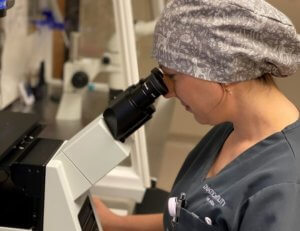Learn how embryo grading works
 Embryo grading helps your fertility specialist choose which embryo is most likely to result in a healthy pregnancy. It’s not a foolproof method that guarantees pregnancy or a live birth, but a good grade gives our Louisiana IVF specialists more confidence that pregnancy can be achieved by transferring just one embryo, which can help reduce the risk of a high-risk twin pregnancy.
Embryo grading helps your fertility specialist choose which embryo is most likely to result in a healthy pregnancy. It’s not a foolproof method that guarantees pregnancy or a live birth, but a good grade gives our Louisiana IVF specialists more confidence that pregnancy can be achieved by transferring just one embryo, which can help reduce the risk of a high-risk twin pregnancy.
Embryo grading 101
To grade your embryos, an embryologist will examine each embryo carefully under a high-powered microscope. The IVF lab will update our Louisiana IVF specialists on your embryos’ development over the course of several days.
The embryologist first checks your embryos on Day 1 after fertilization, examining pronuclei to see if they are lining up appropriately. A normal result would be two pronuclei in each embryo. More than two can indicate an abnormal embryo. An embryo that appears to have one pronuclei will be reevaluated because the pronuclei sometimes lay on top of one another, making it difficult to count them. The embryos are then left to grow in the incubator until Day 3, when they are given a score from 1 (highest quality) to 4 (lowest quality). At this stage, embryos should have six to eight cells that are symmetrical and about the same size.
Embryo grading happens once your embryos have reached the blastocyst stage, typically on Day 5. At this stage, an embryo has 50 to 150 cells and has started to develop different areas. The center of the embryo should fill with fluid, while an inner cell mass should develop that will become a baby. Other cells form the trophectoderm, which should later become the placenta.
Several factors are necessary for an embryo to become a baby, so our IVF lab’s grading system assigns a number or letter grade to each of them.
- A numerical expansion grade, from 1 (least expanded) to 5 (fully hatched)
- A letter grade for the inner cell mass, from A (many tightly packed cells) to C (very few cells)
- A letter grade for the trophectoderm, from A (a cohesive layer of many cells) to C (very few large cells)
Using this embryo grading method, an embryo graded 5AA would be the highest quality, while an embryo graded 1CC would be the lowest quality and less likely to develop.
Grades aren’t everything
Just as a school grade doesn’t always reflect a child’s intelligence, an embryo grade doesn’t always predict viability. Many lower-grade embryos implant and grow into healthy babies, while some perfect-looking embryos fail to achieve pregnancy. Unless you elect to have your embryos genetically tested, your fertility specialist will likely transfer the highest-quality embryo available. Even so, it’s impossible to predict the success of an embryo transfer with 100% accuracy.
To learn more about our embryo grading methods and what we look for in a high-quality embryo, contact us to schedule an appointment with one of our Louisiana IVF specialists.


